In the world of pet companionship, dogs often steal the spotlight for their perceived loyalty and affection towards humans, especially babies. Cats, on the other hand, have long been labeled as solitary and indifferent. But a heartening video shared on TikTok challenges this stereotype, showcasing the remarkable bond between a protective feline named Teddy and his human baby brother, William.
A bond that started from day one.
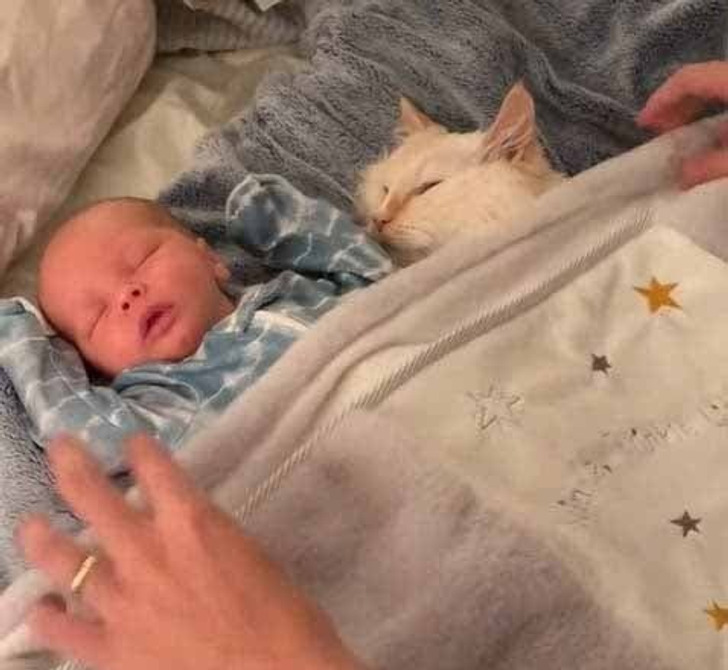
From the moment William entered the household, Teddy, the family cat, embraced him with open paws, assuming the role of a caring and watchful «big brother.» Contrary to expectations, Teddy didn’t display an ounce of jealousy but instead showered the newborn with affection and protection, much to the delight and surprise of his owners.
Capturing these precious moments on camera, William’s parents shared their growing friendship on TikTok, where it quickly gained attention from viewers worldwide. In the videos, Teddy is seen gently interacting with William, ensuring his safety and even playfully engaging with him in his baby seat. It’s evident that Teddy sees William as his own, forming an inseparable bond that transcends species.
One video went viral.
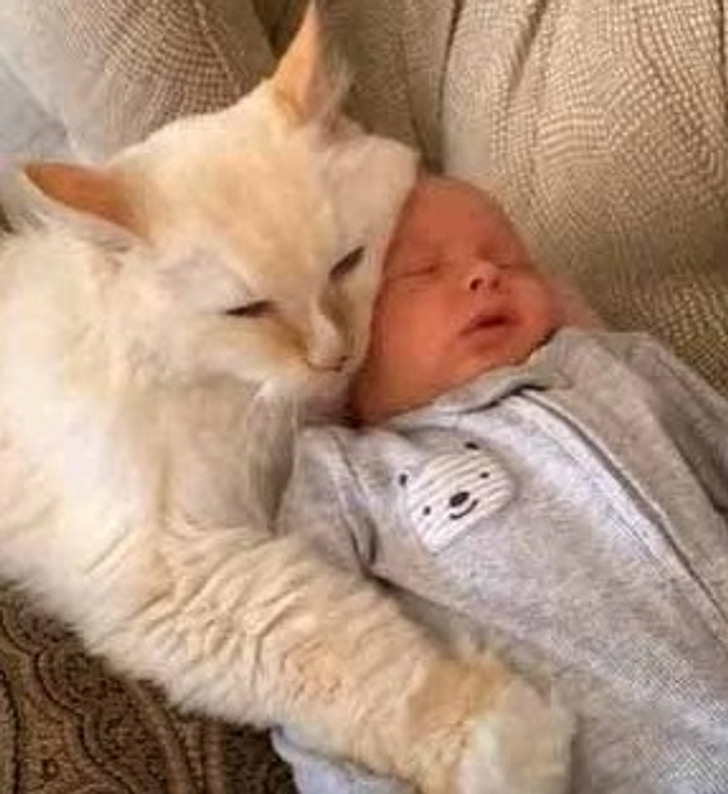
William and Teddy’s TikTok videos are a massive hit, with one in particular reaching almost 12 million views. Witnessing the cat’s tender and affectionate behavior towards the baby brings joy to all who watch their interactions. Whether it’s sleeping next to him, keeping watch over his dreams, or delicately holding him with his paws, the cat’s unwavering commitment to the baby is evident. Refusing to leave his side, the cat seems to intuitively understand the fragility and vulnerability of the little one, embodying a protective presence that touches the hearts of all who witness their bond.
Happy comments flooded in.
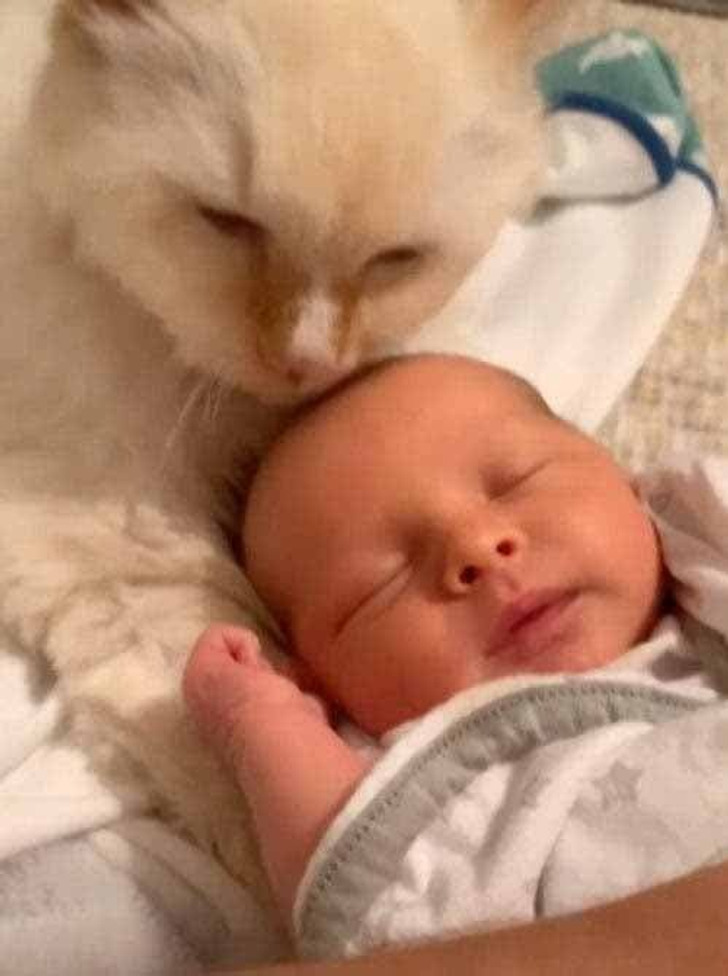
The touching videos shared by William’s parents evoke a range of emotions from viewers, with many expressing admiration for Teddy’s unwavering devotion to his baby brother. Comments flooding the videos reflect the universal appeal of their bond, with some jokingly suggesting that William may have become Teddy’s surrogate. «Could anything be more precious?» one user mentioned. Indeed, Teddy’s nurturing instincts and affectionate behavior have earned him the title of a first-rate babysitter in the eyes of his adoring fans.
While others worried about the cat and baby close together.
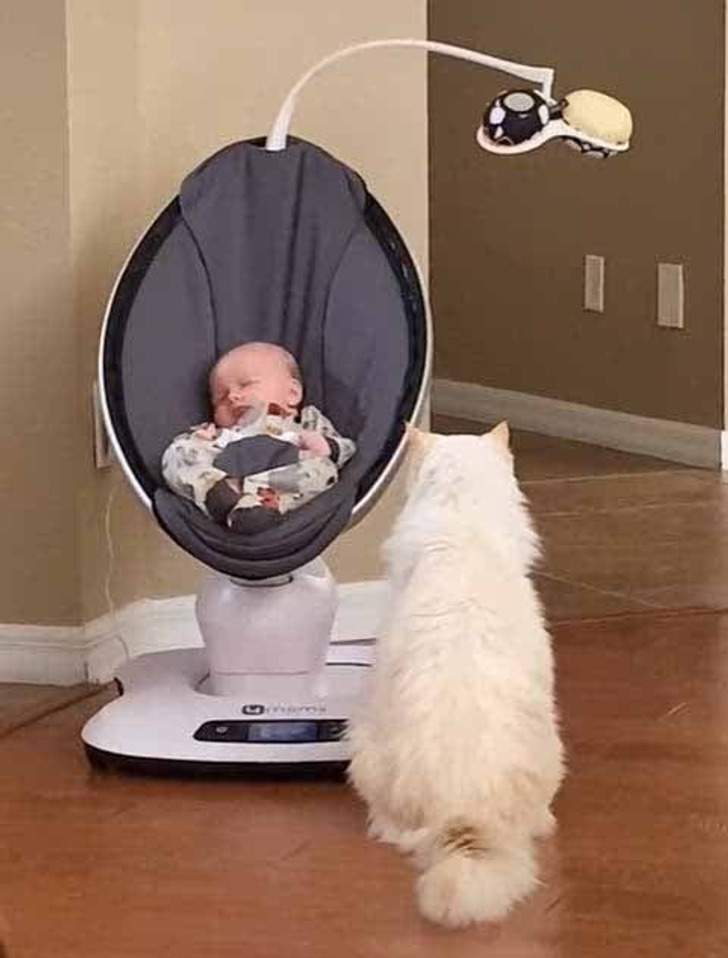
Some people expressed concerns about allowing pets near newborns. In one of the videos, we can see comments saying «Please be careful.» Allowing cats near babies is a matter of personal choice and depends on various factors, including the temperament of the cat, the health and safety concerns of the baby, and the supervision provided by the parents or caregivers.
While many cats can coexist peacefully with newborns and even develop strong bonds with them, it’s essential to exercise caution and take appropriate precautions to ensure the safety of both the baby and the cat. However, Teddy and William’s interactions challenge preconceived notions about cats’ personalities and showcase the depth of empathy and compassion these creatures are capable of displaying.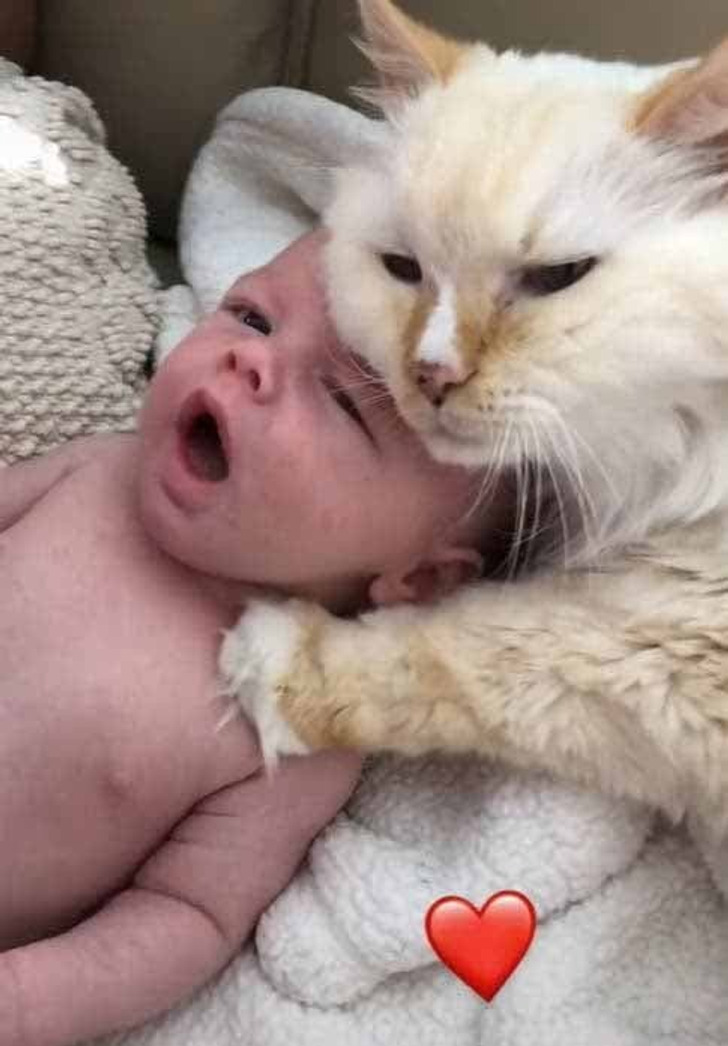
As Teddy continues to watch over William, offering comfort and companionship in his own feline way, their story serves as a heartening reminder of the transformative power of love, transcending boundaries of species and age. In a world often divided by differences, the pure and unconditional bond between a cat and a baby provides hope and warmth, reminding us of the inherent goodness that exists within us all.
Woman Hated Her Mother-in-Law Until One Day When Her Life Was Turned Upside Down — Story of the Day

Mary’s marriage to Ed came with a price: his mother Scarlett who never hid her disdain. From wedding-day insults to constant criticism, Scarlett seemed set on making Mary’s life difficult. Tensions grew with each visit… until something even more shocking unfolded.
Mary and her husband, Ed, drove in silence toward his mother Scarlett’s house. Though they hadn’t arrived yet, Mary was already looking forward to the ride back. Scarlett, after all, simply despised her.

For illustration purposes only. | Source: Midjourney
At their wedding, Scarlett had even shown up wearing a veil; Mary had been grateful she hadn’t arrived in a full wedding dress. Scarlett was one of those mothers who couldn’t let go of her “little boy,” no matter how grown-up he was.
As they pulled into the driveway, Mary reluctantly stepped out, trailing behind Ed. She took a deep breath, steeling herself for whatever latest insult Scarlett had in store.
Forcing a smile, she braced herself, hoping her expression would carry her through this visit. Scarlett opened the door with a wide grin and immediately wrapped her arms around Ed.

For illustration purposes only. | Source: Midjourney
“Oh, my baby! You’re finally here! I’ve missed you more than you know!” she exclaimed, holding him close.
“Mom, it’s only been a week,” Ed replied, easing himself out of her hug.
Scarlett gave Ed a brief look before turning her gaze to Mary, her expression shifting. “Well, Mary, I see you’ve gained a few pounds,” she said with a smirk.
Mary let out a quiet sigh, resisting the urge to respond. She forced a tight smile instead. “Good to see you too, Scarlett.”

For illustration purposes only. | Source: Midjourney
Dinner felt endless as Scarlett launched into her usual list of complaints. “Mary doesn’t know how to cook. She doesn’t work somewhere respectable. She doesn’t even know how to dress herself properly,” Scarlett declared, taking quick glances at Ed for support.
Mary gripped her fork tightly, biting her tongue. She knew any response would just add fuel to Scarlett’s fire. But then Scarlett said something that made Mary’s patience snap—words sharper than anything before.
Scarlett looked across the table, her eyes fixed on Mary. “Well,” she said slowly, “I think it’s high time you gave me a grandchild. Or maybe,” she added with a smirk, “Mary has… some issues?”

For illustration purposes only. | Source: Midjourney
Mary’s heart sank. They had been trying for a baby for six months with no success, and Scarlett’s words stung like salt in a wound. “How dare you!” Mary burst out. “Stop meddling in our lives! Maybe it’s your son who has the problem!”
Scarlett leaned back, eyes narrowing. “That’s absurd! My son is perfectly healthy, thank you very much. But you, Mary… who knows what you were up to before meeting Eddie?”
Mary’s face flushed with anger. “You’re a damn witch!” she shouted, her voice trembling. She turned to Ed, who hadn’t said a word. “Are you just going to sit there and let her say this?”

For illustration purposes only. | Source: Midjourney
Scarlett shot her son a pointed look. “Yes, Eddie, tell your crazy wife to show some respect,” she said, her tone mocking.
Ed shrugged, still scrolling through his phone. “Work it out yourselves.”
Scarlett leaned toward Mary, her voice low. “My neighbor mentioned herbal teas. She swears they help people like you.”
Mary opened her mouth to retort but felt a sudden wave of nausea. She clenched her stomach, forcing the words out. “Why don’t you… drink your own tea?”

For illustration purposes only. | Source: Midjourney
Unable to hold it back, Mary bolted to the bathroom. When she returned, still pale, she looked at Ed. “I want to go home.”
“Okay,” he said, barely glancing up.
Scarlett tilted her head, a fake look of concern crossing her face. “What’s wrong? Are you feeling sick?”
Mary’s eyes narrowed. “You probably poisoned me,” she muttered, too tired to argue further.

For illustration purposes only. | Source: Midjourney
On the way home, Mary’s mind raced. She had to know for sure. “Ed, can you stop at the pharmacy?” she asked quietly.
He sighed but pulled into the parking lot. She hurried inside, grabbed a pregnancy test, and paid quickly. Back at home, she went straight to the bathroom. She held her breath, waiting. Then, the results appeared—two lines. She gasped, feeling a rush of excitement and relief.
She rushed to show Ed, her face glowing. “Ed, we’re going to have a baby!”

For illustration purposes only. | Source: Midjourney
Ed glanced at the test, his expression unreadable. “Oh. That’s… good,” he mumbled, barely meeting her eyes.
Mary’s heart sank a little. She was overjoyed, but Ed’s reaction felt like a shadow over her happiness.
A few weeks had passed since Mary found out she was pregnant, and she was finally starting to adjust to the idea of becoming a mother. It was their first doctor’s appointment, and she was sitting on the bed, waiting for Ed to finish his shower so they could leave together.

For illustration purposes only. | Source: Midjourney
She hoped he’d show some excitement, but he seemed distant lately, preoccupied and withdrawn
As she waited, Ed’s phone buzzed beside her, lighting up with a message. Usually, she respected his privacy. But the way he’d been acting made her hesitate.
Without fully realizing it, she reached for his phone. She tried to unlock it and was surprised to find a passcode. She couldn’t remember him ever using one before. On a whim, she tried his birth date. The screen unlocked immediately.

For illustration purposes only. | Source: Midjourney
The message stared back at her: a picture of a half-dressed woman, smiling in a way that made her stomach twist. Below the picture, a message read, “Can’t wait to see you, baby.”
Her hands trembled as she scrolled through the conversation, each word feeling like a fresh betrayal. Ed had told this woman he was wealthy, a construction company owner—a far cry from his real job.
Heart pounding, she took screenshots, saving them on her phone as evidence of his lies and deceit.
When Ed came out of the bathroom, she was waiting, holding his phone. Her face was pale, her eyes filled with hurt and anger.

For illustration purposes only. | Source: Midjourney
“What is this?!” she shouted, thrusting the phone toward him.
His expression turned hard, and he grabbed the phone from her hand. “None of your business,” he snapped.
Mary’s voice rose, filled with pain. “None of my business? You’re cheating on me! And I’m pregnant, Ed—your pregnant wife!”
His eyes narrowed. “Maybe you’re the one cheating on me,” he shot back, a sneer forming on his face. “How do I even know this baby’s mine?”

For illustration purposes only. | Source: Midjourney
Mary felt her whole world spin. “Are you serious? We’ve been trying for six months. Now you’re saying this?” Her voice broke.
Ed crossed his arms. “Six months, no luck, and now all of a sudden it just happens? Convenient.”
“You’ve been seeing this woman for more than six months, Ed. I saw everything. You’ve lied to her, too! Told her you’re rich, that you own a company!” Mary’s voice trembled.
Ed shrugged, coldly unmoved. “Doesn’t matter. I’m filing for divorce. This marriage is over.”

For illustration purposes only. | Source: Midjourney
“You really think that woman will stick around when she learns the truth about you?” Mary shot back.
“Trust me, she won’t find out. And when this is over, I’ll take this house and everything else you have. Plus, my mom’s money.” He smirked.
Mary’s voice rose in protest. “This house was bought by my father!”
“Yeah? It’s in both our names,” Ed replied with a smug smile.

For illustration purposes only. | Source: Midjourney
Mary’s voice softened as she asked, “What about the baby?”
Ed just shrugged. “You can’t prove it’s mine until it’s born. By then, it’ll be too late.” And with that, he threw her out, leaving her in tears.
Desperate and hurt, Mary made a choice—to go to Scarlett and show her everything. Scarlett had to know the truth about her son.
She sat across from Scarlett, her heart pounding as she told her everything—Ed’s lies, his cheating, his threats to take the house. She held her breath, waiting for Scarlett to dismiss her. But to her surprise, she listened, her face growing pale.

For illustration purposes only. | Source: Midjourney
Scarlett looked down, tears welling in her eyes. “He’s been taking money from me too,” she said softly. “Every penny his father left me, everything I’ve saved. He said he needed it for doctor visits because you couldn’t get pregnant.”
Mary shook her head, feeling both anger and sadness. “He never even went to a doctor. Every time I brought it up, he refused. I checked our account, Scarlett. He’s been taking out huge amounts.”
Scarlett clenched her fists. “I can’t believe my son would do this,” she said, her voice shaking. “He lied to both of us.”

For illustration purposes only. | Source: Midjourney
Mary’s voice broke as she spoke. “I don’t know what to do. I’m pregnant, and he says he’ll take everything. He doesn’t even believe the baby is his.”
Scarlett’s eyes hardened. “I won’t let anyone hurt my future grandchild,” she said firmly. “We’ll make him pay. You have those messages saved, right?”
Mary nodded. “Yes, I took screenshots.”
Scarlett thought for a moment, then said, “I have one of his toothbrushes here. We can get a DNA test when the baby is born.”

For illustration purposes only. | Source: Midjourney
Mary looked at Scarlett, surprised. “You’ve never been on my side before. What changed?”
Scarlett sighed. “I was a mother trying to protect her son. But now I see I need to protect others from him. His father was the same—a cheater. I endured it, hoping Ed would be better. But he isn’t. And I don’t want anyone else to suffer like I did.”
Mary and Scarlett moved forward with their plan. Mary confronted Ed directly, and she showed him the screenshots of his messages.
“I have all your messages,” she said, her voice steady as she held up her phone. “And I’ve already shown them to Scarlett. So you have no more room to manipulate anyone.”

For illustration purposes only. | Source: Midjourney
Ed looked shaken, but Mary continued, not backing down. “Here’s the deal,” she told him firmly. “Give up your claim to the house, sign these divorce papers, and agree to pay child support. Do this, and I’ll stay quiet. Otherwise, I’ll make sure your lover knows the truth.”
Backed into a corner, Ed reluctantly agreed and signed the papers without a word. He had no idea that Scarlett had the final piece of the plan.
Scarlett went to Ed’s lover herself, revealing everything—his lies, his fake claims of wealth, and his deception. She left nothing hidden, ensuring her son’s lies would come crashing down.

For illustration purposes only. | Source: Midjourney
When Ed found out, Scarlett was sitting with Mary, enjoying tea at her house. Suddenly, loud banging echoed from the front door, followed by Ed’s furious shouting.
“You promised you wouldn’t tell if I did everything you asked!” he yelled through the door, his voice sharp with anger.
Mary looked at the door calmly and replied, “I didn’t tell her anything, Ed.”

For illustration purposes only. | Source: Midjourney
Scarlett raised her voice so Ed could hear. “I did,” she called out firmly. “I taught you that lying is wrong, but you clearly didn’t learn.”
“You’re both insane!” Ed shouted, his voice shaking with rage. “You’ll regret this! I’ll make you pay!”
Just then, the police arrived, alerted by a neighbor’s call. They restrained Ed, leading him away as he continued yelling threats, while Mary and Scarlett stayed inside, unshaken while finishing their tea.

For illustration purposes only. | Source: Midjourney
Tell us what you think about this story and share it with your friends. It might inspire them and brighten their day.



Leave a Reply